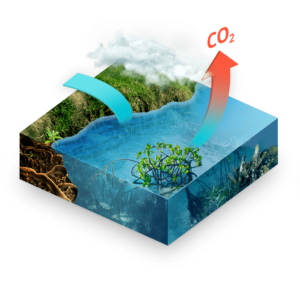IPCC Report Urges Global Community to Keep Warming Below 1.5°C
Mangrove ecosystems are threatened by the impacts of rising temperatures but are also a powerful tool in mitigating warming and disasters, experts say
The Intergovernmental Panel on Climate Change released a report on October 7 detailing the global impacts of rising temperatures and urging accelerated efforts to meet the Paris Climate Agreement goal of limiting warming to 1.5°C. It encourages the development of large-scale “negative emissions” systems to sequester carbon dioxide from the atmosphere. While the basic technologies for this are still developing, IPCC experts highlight the role of nature – particularly mangroves – in helping to meet this goal while providing a suite of other ecosystem services that are vital for communities adapting to a changing climate reality.
Carbon Storage
Mangrove forests are one of the most impactful  carbon-trapping ecosystems, outpacing even tropical rain forests. They are effective at locking away vast amounts of “blue carbon” and the IPCC report encourages the protection of coastal vegetative ecosystems as part of integrated coastal resource management. But more potent than their sequestration powers is how their destruction would actually contribute to global warming. Mangrove loss releases ancient carbon and methane that was stored in the waterlogged peat beneath the forest. Preventing deforestation in these ecosystems is a bigger climate win than in many other places.
carbon-trapping ecosystems, outpacing even tropical rain forests. They are effective at locking away vast amounts of “blue carbon” and the IPCC report encourages the protection of coastal vegetative ecosystems as part of integrated coastal resource management. But more potent than their sequestration powers is how their destruction would actually contribute to global warming. Mangrove loss releases ancient carbon and methane that was stored in the waterlogged peat beneath the forest. Preventing deforestation in these ecosystems is a bigger climate win than in many other places.
Coastal Adaptation
 The IPCC report encourages integrated coastal zone management that recognizes the importance and economic expediency of using natural ecosystems such as mangroves to protect coastal communities. In some cases, restoration of coastal habitats and ecosystems can be a cost-effective way of responding to challenges from rising sea levels, intensifying storms, coastal inundation, and salinization. Mangrove protection and restoration are ecosystem-based adaptation measures that reduce the risk of warming-induced coastal disasters.
The IPCC report encourages integrated coastal zone management that recognizes the importance and economic expediency of using natural ecosystems such as mangroves to protect coastal communities. In some cases, restoration of coastal habitats and ecosystems can be a cost-effective way of responding to challenges from rising sea levels, intensifying storms, coastal inundation, and salinization. Mangrove protection and restoration are ecosystem-based adaptation measures that reduce the risk of warming-induced coastal disasters.
When incorporating mangroves in community protection the report underlines that considerations must be made to allow mangroves to adapt to changing tides. They must be able to shift inland as sea levels rise, or else they can face “coastal squeeze” where they are trapped between changing ocean conditions and coastal infrastructure. Local watersheds must also maintain sediment supply that enable mangroves to make this shoreward move.
Threats to Mangroves
These adaptations do have their limits, however. The report states that current ecosystem services from the ocean will be reduced at 1.5ºC, with losses being greater at 2ºC. Rising sea levels, increasingly damaging tropical storms, and temperature extremes threaten mangroves. Secondary effects from community responses to climate change — including changing agriculture systems, reduced freshwater runoff, and deforestation — are also potential risks.
